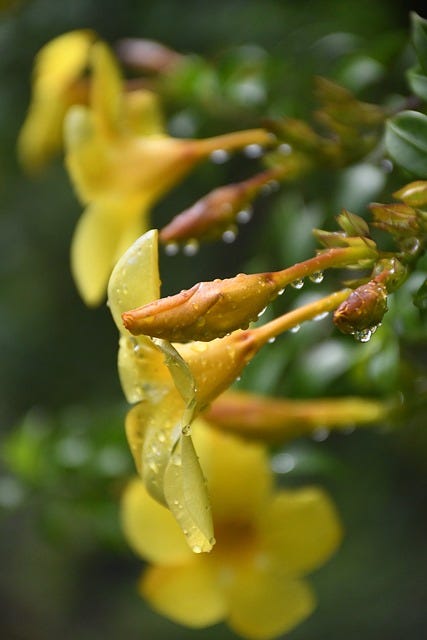A southern native plant that kills honey bees: What to avoid in your yard
While conserving and expanding native plants and habitats has many benefits, some native plant selections can fatally affect some animals, like honey bees.
I learned about our southern native Carolina Jessamine (Gelsemium sempervirens), also known as yellow jessamine, during an 11-week beekeeping school in 2017. When I heard the instructor talk about jasmine, my ears perked up. I love the aroma of jasmine and had hoped to add it to our yard. Carolina Jessamine is pronounced the same as jasmine, phonetically, jazz-mehn. It wasn’t until the speaker switched the slide in their presentation and showed the spelling of the plant name that I realized it was a different plant. Both are beautiful aromatic vines, but the jasmine I was thinking of was a white-flowering vine native to Asia.
Non-beekeepers usually get surprised when they hear that a native plant is toxic to honey bees because they don’t realize that honey bees (Apis mellifera) are not native to North America. Like many Americans, today’s honey bees across the United States descend from immigrants. Many honey bees come from Italian descent. Some are Carniolan (from Slovenia and surrounding areas). In talking with beekeepers in Western North Carolina, they like to call theirs “mountain mutts” and have bred a few different European varieties over the years. Among beekeeping circles, Russian bees have a reputation for being more hygienic when it comes to Varroa (Varroa destructor) mite management, and also high honey producers. One thing all of these European honey bees have in common is that Carolina Jessamine is their kryptonite. (If you’re curious to learn more about different types of European honey bees, please comment and I’ll plan a separate post dedicated to breaking down the varieties.)
The beekeeping school speaker, who’s also one of our North Carolina State Apiary Inspectors, shared stories of dead colonies he came to inspect and then discovered Carolina Jessamine blooming nearby. Carolina Jessamine not only harms honey bees, but if ingested in certain quantities, it’s poisonous to people, cats and dogs, goats, chickens, horses, and some other livestock, according to Colorado State University’s Guide to Poisonous Plants. The plant’s poisonous traits were documented nearly a century ago. The United States Department of Agriculture published “Plant Poisoning of Bees” in 1936. It details the various colony symptoms and losses associated with plant poisoning.
Both the pollen and nectar from Carolina Jessamine has a fatal affect on honey bee colonies. The plant produces a high volume of strychnine-like alkaloids. Strychnine is used as a pesticide. Unlike other pollinators, honey bees practice what’s called “flower fidelity.” Once they find a foraging source, they consistently return until they completely deplete that source. This means if Carolina Jessamine starts to bloom, honey bees will discover it and fill their hives with the pollen and nectar until they’ve completely exhausted the plant. The bees essentially fill their colonies and feed their brood a pesticide.
With fall planting on our horizon, I wanted to dedicate a post specifically as an educational warning to avoid introducing this plant into your landscape. I also highly encourage you to remove it and replace it with another plant (or two or three!). I love Carolina climbing aster (Ampelaster carolinianus) and it blooms with bright purple flowers in late fall to early winter. Like Carolina Jessamine, climbing aster is evergreen but it’s not fragrant. Climbing aster not only gives a pop of color at a time when not much blooms, but more importantly it provides a safe nectar source at a time when honey bees and other pollinators have a challenging time foraging.
A few months after beekeeping school, I stopped at a local nursery. The entrance to the nursery was an archway of gorgeous yellow flowers—Carolina Jessamine. I also noticed they had several of the vines for sale. While buying some (other) plants and some tools at the checkout, I asked the nursery associate who I could chat with about displaying warnings on plants. She connected me with the owner and I explained the fatal impacts of the plant, that North Carolina has the largest beekeeping association in the country, and that it would be good citizenship and stewardship on her part to display a warning with the plants she had for sale. (Ideally, I wanted to suggest she remove the plants altogether, but I figured a warning sign would be an easier starting point.) She shook her head, waved her hand, and scrunched her face up—obviously annoyed with me. Her rigidness and lack of concern turned me from a first-time customer to a one-time customer.
Fortunately, I haven’t seen Carolina Jessamine for sale anywhere else locally. I encourage you to speak up if you see it for sale somewhere—even if you don’t live in the South, it’s fatal to honey bees everywhere. If you come across nursery owners who don’t realize it’s a poisonous plant to a very special pollinator—our state insect for that matter!—that’s OK. However, I feel some action is necessary once they get enlightened.
One unfortunate thing is that our neighboring state, South Carolina, chose Carolina Jessamine as their state flower.
Help spread the word. Share this post to help educate others about this toxic plant.




